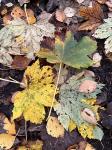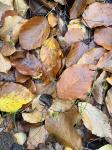Brayton Barff Through the Seasons.
Set in the Vale of York, South West of the market town of Selby and between the villages of Thorpe Willoughby and Brayton, lies Brayton Barff, a sandstone Hill approximately one hundred and fifty feet in height which was formed by glacial movement during the last Ice Age. It is a significant landmark in an otherwise flat landscape.
Today the site is primarily owned by Yorkshire Water with Selby District Council owning a small patch of the land adjacent to the A63 Selby bypass. A large underground reservoir occupies the centre of the site which delivers water to around 4.7 million customers throughout Yorkshire.
Within the Barff woodland over 40% of the trees are Sessile Oak which are generally found in semi natural woodlands in the north of the country. These trees are so called because its acorns are not held on stalks, like those of the English Oak (Pedunculate), but attached directly to the outer twigs. There are also several English Oak trees as well as some cross-hybrid oaks. These trees are known to support many species of flora and fauna, invertebrates, mosses, lichen and fungi.
During the Victorian times it is thought that the shipbuilders on the east coast would come over to the Barff for selected cuts of timber to build their sea going vessels.
The Barff also has a variety of other trees including Silver Birch, Beech, Sycamore, Holly, Rowan, Scots Pine, Alder, Hawthorne and European Larch. There are also several Yew, Willow, Hazel, Horse Chestnut and Wych Elm. As with similar woodlands there are a variety of bushes, including Honeysuckle, Elderberry, Gorse, Broom and Buddleia.
The history of Brayton Barff is quite vague, apparently during 1803 a beacon was lit on the Barff when the country was threatened with an invasion by Napoleon. In May 1935, to celebrate King George V's Silver Jubilee, a Bonfire was lit on the Barff as part of the celebrations.
Early issues of Ordnance Survey Maps dated 1903 clearly show a rifle range on the Barff, extending out to Mill Lane. During the 
Between 2001 – 2004 the A63 Selby bypass, 10km twin lane single carriageway was constructed which severed the South West corner of the Barff, adjacent to Selby Golf Course and resulted in a slight redesign of several holes on the golf course. Wooden fencing was erected as a result of this new road running alongside of the Barff and a footbridge constructed over the ‘new road’ following the line of the Bridal way which extends from Mill Lane. Around 2005/2006 a definite 2metre wide limestone aggregate footpath was laid forming a circular path around the outer edges of the woodland. This footpath is approximately 1.2 miles in length and takes about 30 minutes to circumnavigate at a leisurely pace.
In 2012 the Barff was declared an Ancient Oak Woodland and as such throughout 2012 and 2013 significant work had been carried out by the relevant agencies to cut and remove large swathes of non-native trees, creating at that time huge scars on the landscape. Some three years later the planting of the native trees have become well established and are flourishing. Ongoing maintenance work on the footpath around the bottom of the Barff was completed during the Summer of 2016.
A second phase of woodland maintenance commenced during the Autumn of 2019 with the removal of many old and diseased trees and the cutting back of the Gorse and Broom bushes, especially adjacent to the ‘bypass trail’, this work continued through till March 2020 with re planting continuing into April 2020.
Brayton Barff is a popular site for walkers and bird watchers alike and a path circling the outer perimeter of the Barff makes a pleasant thirty minute walk, giving views looking over towards Selby and the village of Brayton as well as the power stations of Drax and Eggborough..jpg)
For the early risers it is a great place to see some stunning sunrises over the villages of Brayton looking towards Drax Power Station, the same with the Sunsets looking over towards Eggborough and Monk Fryston.
The Barff changes with the Seasons and every visit can reveal something new, the woodland is a haven for wildlife. Records show that since 1982 one hundred and twelve species of bird have been seen in the woodland and at least 40 of those have bred here, including Tawny Owl, Buzzard, Green Woodpecker, Spotted Flycatcher, Goldcrest and Nuthatch to name just a few. On average over 70 species of bird are recorded each year. Further details of the bird life on the Barff can be found on the Brayton Barff Group Facebook page, especially the posts from Derek Cooper. Today ‘The Friends of Brayton Barff group’ led by Derek and a small team of volunteers help keep and maintain the cleanliness of the site as well as recording the wildlife and bird sightings.
The Barff is also home to fifteen different species of mammals, including Muntjac Deer, Pipistrelle Bat, Fox, and Field Vole.
Over eighty species of plant and wildflowers have been recorded, included Bee Orchid, Northern Marsh Orchid, Wood Anemone, Marsh Ragwort, Bluebell, White Bluebell, Bittersweet and Purple and White Foxgloves. Over twenty species of Butterfly have been recorded, including Marbled White, Brown Angus, Speckled Wood, Comma and Brimstone.
During the Autumnal months fungi thrives in this woodland environment, species including Fly Agaric, Beefsteak Tree Fungi, Chicken of the Wood, Sulphur Tufts, Stinkhorn, Ink cap, Puffballs and Hoof Bracket are just some of the many varieties that can be found here.
Click on the galleries shown below to expand the albums.
October 2022
I really do not know where October has gone. Here we are in the depths of Autumn, one of my favourite months, and on a Sunny day the Barff looks beautiful with the golden array of autumnal colours. We have seen some beautiful sunrises during October, but most of the mornings have been dull, dark, damp and humid, averaging 12C and wet underfoot, from the heavy overnight rain. That said, I have only had to wear my waterproofs on two or three occasions for the morning walk, so I shouldn’t really complain.
Most of October was actually warmer than average for this time of year, though the second week was rather cooler, and the last ten days were especially mild relative to the average, with a notable lack of frosts. At the same time, the month was predominantly unsettled, with no dry spells longer than a couple of days. However, sunshine was above average for most of us.
The humid temperatures of late has seen a huge increase in the amount of fungi in the woodland, especially Fly Agaric, Sulphur Tuft and Shaggy Parasols. The Sulphur Tufts seem to thrive on the old decaying moss covered tree stumps, whereas the Fly Agaric, although native to the UK, favours the sheltered spots amongst the birch and pine trees, often hidden away under the leaf litter and bramble bushes. The Shaggy Parasols on the other hand, tend to pop up anywhere in the woodland and are renown for growing in rings, known as fairy rings, which has long been part of our folklore. Some believe the rings symbolised a place where fairies, pixies or elves danced in the woods, others believe that they were a portal between the fairy world and the human world. That aside, the rings are actually a natural phenomenon resulting from the way the mycelium underground grows. Starting at a single point it grows outwards in a circular motion, searching for more nutrients. Over time, the circle of fruiting bodies above ground will appear in an ever-widening circle, reflecting the mycelium beneath pushing ever outwards.
I have been quite fortunate to have had some very early walks with Meg and Gracie this month, they too seem to prefer the early mornings (so they can spend the rest of the day sleeping!) Although it is dark at 6.00am, I have been able to listen to the Tawny Owls calling to each other, I don’t know if it is my headlamp or the dogs illuminated collars which disturbs them, or that they are just noisy, but I have certainly heard four birds calling to each other with their twit twoo’s, one pair very close to the old swing tree/pump house area, the other pair over near to where the old farm shop used to be or the service entrance to the woodland. Obviously, they seem to be thriving at the moment living on the small mammals that live in the woodlands. Like the Owls, I have heard the Buzzard calling on many of my morning walks amongst the woodland, its distinctive call is quite noticeable and distinctive. The call of the buzzard is a very plaintive, long 'peeee-uu' note, which is made at any time of year. I often see it soaring high in the sky above the woodland but can occasionally be seen perched in trees or on posts where it has a good vantage point to swoop down to feed on the Braff’s small mammals, rabbits, and birds, as well as carrion. During the coming winter months, it may even be seen on the ground hunting for worms.
The Grey Squirrel population seems to be holding its own. I often have to stop and watch as the youngsters fight and squabble with each other amongst the tree branches, they usually communicate using their tails but occasionally they can be heard chattering to each other. This year, unlike last year, has been an excellent year for Acorns, the Barff footpaths and trails have been covered in them, the area around the old oak swing tree is still quite perilous as you walk beneath it.
The trees are still shedding their leaves, although many started losing them back in August due to the lack of rainfall at that time. The overnight rain and winds of late are bringing them down on a daily basis, covering the woodland floor in a huge blanket of many colours. Once the frost begin with the onset of winter the remainder will soon fall. The ferns are steadily changing colour and dying back, as are the nettles, they have had a bumper year, in places they have grown to between five to six feet in height and if you are unfortunate to get caught, leave you with a nasty itchy stinging rash on your flesh.With all the rain, many of the trails and path leading off from the perimeter footpath are becoming very wet and muddy and will probably stay like that till next spring.
There is still lots of bird song to be heard and birds to see around the Barff, most of our summer visitors have returned to warmer climates in Africa though Chiffchaff and Blackcaps could still be heard early on in the month, I haven’t heard any recently so presume they must have flown. The tiny Goldcrest can still be heard, their short high-pitched song often repeated several times in a minute is quite distinctive from the other birds. Great and Blue Tits, Chaffinch, Robins and Dunnocks can still be heard calling amongst the shrubs and trees. Long Tailed Tits, Nuthatches and Wrens too are still quite active and can be heard most days. It has been nice to stand and watch the finches feed on the Rowan berries of late, I’m going to have to spend some time up there filming them I think.The woodland is certainly preparing itself for the colder months ahead. Let’s see what November throws at us.
|








